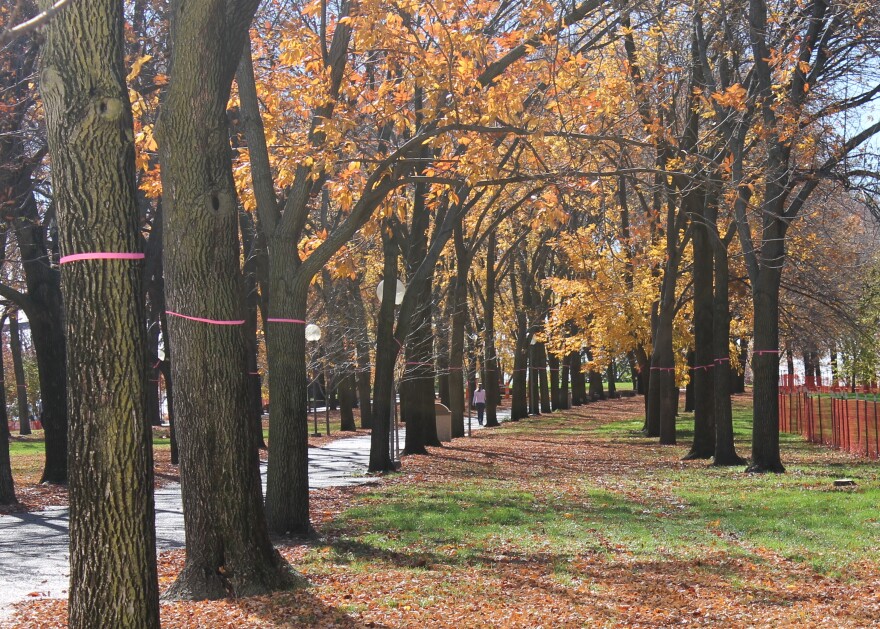The National Park Service will start removing 1,200 trees on the Gateway Arch grounds in earnest on Monday.
The removal is part of a years-long project by CityArchRiver to renovate the popular tourist attraction, and it could start as early as Friday, according to the group's communications director Ryan McClure. He said the first few trees are coming down Friday to move in construction equipment.
Trees throughout the Jefferson National Expansion Memorial have been marked for removal with pink ribbons. They include 800 ash trees being preemptively cut down before falling prey to an invasive beetle known as the Emerald Ash Borer.
Better conditions

National Park Service historian Bob Moore said most of the trees are already at the end of their natural life span due to poor growing conditions.
"We've got originally bad dirt, extra bad dirt, and then conditions like confining tree pits, bad irrigation and bad drainage of water when it rains," Moore said. "You could go on and on, a high pH to the soil. It's just a bad place to try to grow anything."
According to Moore, the renovation to the grounds will create a healthier environment for new trees to thrive, with better configurations, drainage and topsoil. The new trees will begin being planted in spring of 2016.
"Things will be remedied," he said. "That's why so many trees have to come out. We have to start from scratch in some respects just to make it work. It hasn't worked in 25 years."
New plans, old vision
The changes will also bring the grounds into closer alignment with the original vision for the site designed by renowned landscape architect Dan Kiley. While most of the trees will be replaced with new ones of the same species, the vulnerable ash trees' replacements proved a challenge. Moore said a long process whittled down a list of 500 potential tree species to a short-list of 12.

The winner was the London Plane Tree, which Moore said was Kiley's "second choice for the type of tree species he wanted on the the Arch grounds." Particularly, they grow into the kind of shape Kiley envisioned canopying the borders of walkways.
"So we’re actually getting it closer to Dan’s concept was than even the ash trees, which were a replacement, not the species he wanted," Moore said. "I think in some respects we almost got there, almost got what Dan was thinking; I think this time around we can get it right."
The hardy species, which is less susceptible to disease and pests and grows well in polluted urban environments, is the same as that which grows in Paris' Champs-Élysées and the Tuileries Gardens. In fact, it was the latter site that inspired Kiley's plans at the Arch.
"He wanted to...pay homage to that and design something that gave a similar feeling to what you have when you walk on grounds there," Moore said.
While the ash trees will be cut down in favor of the London Plane Trees, Moore said they'll still be there, in a way: in the form of mulch.
Respecting history
In addition to reflecting Kiley's original ideas, Moore said the renovation is also being done with an eye toward historical continuity.
"We're making sure things don’t change radically, so people coming back generation after generation will get the same feeling and ambience," Moore said. "If you come back here in 2017 or '18, you would swear it's going to be the same. I mean what they replace things with, it's going to look very close to what's here now, but it will be a completely different condition."
But as plans for the new trees align the site more closely with Kiley's historical vision above ground, Moore said the past below the site must also be respected.

Moore said much of today's grounds lie on top of the original city of St. Louis. The remains of old city grids that once held French colonial and early American towns and commercial districts, exist beneath the surface after being torn down in the 1930s.
"When they made way for the arch, they basically just tore down all the buildings that used to be here, and they're still underneath us," Moore said. "So brick and concrete and iron and all kinds of things are down there."
While in most areas, the building remnants are several feet beneath the earth, some are fairly close to the surface. So as the renovations continue, archeologists will be on hand to make sure that any artifacts unearthed by bulldozers are properly handled, Moore said.
It's a valid concern: earlier this year, archeologists with the Missouri Department of Transportation found evidence of French colonial homes under the Poplar Street Bridge.
"We have to be very careful we don’t bypass history again or...miss out on information that could be buried in the ground," he said.




